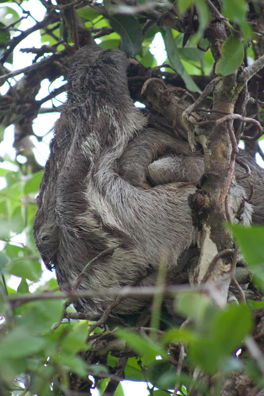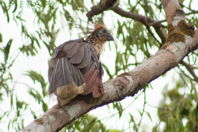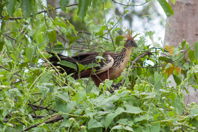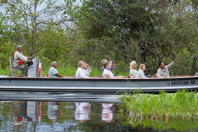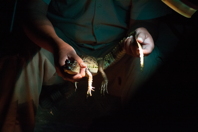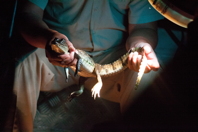
|
| Another house, this one just barely escaping inundation (bigger version). |
Friday, April 17, fourth day in Perú ( II )
On the Amazon
I have an extensive description of the next doings in my journal. It begins:
«Before lunch, we had a talk about the two kinds of river dolphin. Chino said that they are hunted elsewhere in South America, but here, the locals’ superstitions prevent harming the animals.
«After that, Javier told us about the local fruits, of which there are many. [And Mark has an extensive account, with pictures, on his page.] Most of these don’t ship well, with the exception of Brazil nut and “camu camu”, a small fruit maybe 1.5 times the size of a small grape, with a leathery skin and a set of several tight-packed seeds. [We had been having these at some of our meals, without knowing what they were. I found them delicious, though others thought that they were too sour.] The flesh is a relatively thin layer between the seeds and the skin, but is extremely tart with a pleasant flavor. Supposedly an exceptionally rich source of vitamin C.
«Lunch was the roe of some fish or another, with other goodies, all set into a fried cup made of shredded blue potato. All edible. The foregoing was the appetizer, and the main course was fish steamed (maybe poached) in a banana leaf, with an associated thin sauce that had pea-sized yellow chilis floating in it. We were warned against eating these; the liquor they were floating in was extremely hot already. There were also three strips of fried cassava (yuca) with a nice sauce for spooning over them or dipping them into.
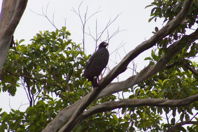
«Dessert was various fruit evidently steamed in a different kind of leaf with star-anise in the mix for flavoring, all presented in a decorated vegetable shell the size of a small cannonball.
«After lunch, a blessed nap, and then another nap. But at 4:30 we went for another expedition by skiff. Lots of Hoatzins this time, but the pictures I got were not nearly as good as the just-average ones that Mark got.»
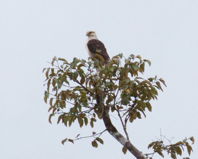
Yellow-headed caracara
(bigger image).
By afternoon, though, the Delfin II was moored to a tree by the side of the river, and we discovered that in this tree there was a sloth. Sleeping, of course. We couldn’t tell for sure, but we thought that it was a mother and baby, all wrapped up together. Couldn’t see anybody’s face, and I couldn’t even tell which limb that was that she was hanging by. Arm? Leg? But there she was, and I took lots of pictures, every one of which looks just like the one above and to the left.
As my journal said, we got moving by skiff by 4:30 or so, and there were pictures to be taken. The two shots of houses inundated or almost so that I headed this page and the previous one with were taken on this trip, as well as the pictures of the great black hawk and the caracara to the right.
In what I said about the Hoatzin before, I kept saying that it was mysterious. The reason is that none of the ornithologists know for sure, nor can agree on, what other birds it may be most closely related to. And it has a skeletal peculiarity that is seen only in the “Enantiornithes”, a birdoid group that went extinct at the same time that the non-bird dinosaurs did. Hoatzin can’t be one of those, but the whole business deepens the mystery.
Again, I quote from my journal: «This excursion [by skiff] lasted into twilight and beyond. We used the twilight hours for fishing with simple rod, monofilament line attached, to which a small hook was lashed. We used little strips of tenderloin as bait, and just as soon as you dropped the line in, there would be nibbles. I never succeeded in hooking anything, but Mark caught a little red-bellied piranha, while Catherine got one that size, and the biggest of the piranhas that our skiff-riders took. She also caught a river sardine and two catfish, one very fine and suitable for a home aquarium.
«As it got darker, we put away the fishing rods, and went in search of caimans. Apparently Chino could spot the red reflection from their eyes when a light was shined on them. Eventually he saw one, got the skiff right into the grass, and reached down to grab it by the neck. He said that these animals don’t produce adrenalin, so don’t know enough to hide. It was rather docile when he showed it around to us all.»
From there, we returned to the Delfin II, where there was an informative talk about the dolphins, and then dinner. And then to bed for the next day’s adventures.
| Two video clips of about 35 seconds each: | |
| The sediment-laden waters of the Ucayali, at 9:50 a.m. | On the black water of the Dorado, at 5:15 p.m. |
